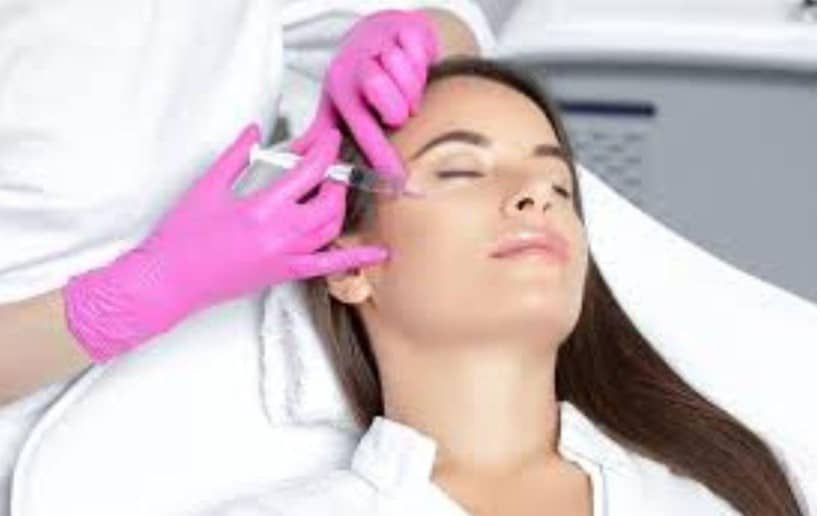Botulinum Toxin Treatment in Bangalore
Botox, short for Botulinum Toxin, is a kind of injectable therapy that improves appearance by reducing, relaxing, or eliminating facial lines, muscles and wrinkles. These injections have several use cases in medical treatments, and some common Botox injection types are Dysport®, Botox®, Jeuveau®and Xeomin®. The function of these Botox injections is to weaken or paralyze particular muscles or block specific nerve signals so that the particular muscle of that area cannot contract. This article will discuss how Botulinum Toxin works, its procedures, cost, benefits, preparations before the treatment, and some FAQs regarding Botox.

What is Botulinum Toxin?
Botox is a kind of medicinal drug made from a toxin developed by the bacterium Clostridium Botulinum. This toxin is the same toxin that induces a deadly food poisoning known as botulism. Researchers and scientists make raw extracts from specific types of bacteria and are most popularly called brands of Botulinum toxin injections. However, doctors use a small weaker dose of Botox to reduce unwanted facial lines and smooth wrinkles or treat facial appearance. Botulinum toxins are neurotoxins that impact nerve signals and cause the muscle of that area to weaken.
Patients with specific health problems and awry appearances undergo this injectable treatment for cosmetic or medical reasons. Surgeons or doctors inject small amounts of Botulinum Toxin into a particular area of the facial muscles to smooth wrinkles, control migraine headaches and treat several other health conditions. These are some of the health issues for which doctors use Botulinum Toxin:

- To temporarily smooth facial wrinkles and improve the facial appearance
- Overactive bladder
- Chronic migraine
- Patients with severe sweating in the underarm region can undergo this treatment. Healthcare providers inject Botox for a condition in which patients sweat a lot even when they do not feel hot or work up a sweat, known as excessive sweating or hyperhidrosis.
- Cervical dystonia or Neck spasms, is a painful condition where patients face neurological disorder that provokes severe neck and shoulder muscle contractions. Patients cannot contract their neck muscles which compel the head to turn or move into an uncomfortable posture.
- Blepharospasm is a condition where patients cannot control their blinking.
- Bladder problems are another health condition treated with Botox. These injectable shots can also help relieve urinary incontinence induced by an overactive bladder.
- This injection treats the laziness in the eye caused by imbalances in the muscles used for moving the eye. This condition of the lazy eye also is known as crossed eyes or misaligned eyes.
- It can treat migraine. Migraine is a throbbing pain in the head that often indicates warning symptoms. Botox injections may help relieve how often patients get a migraine. Healthcare providers use this treatment mainly on patients who experience headaches fifteen or more days a month. Such patients need treatment about every three months to have the advantage of Botulinum Toxin treatment.
Botulinum Toxin Procedures
On the day of your Botox treatment, you should expect the following:
Preparation: Your practitioner will clean the treatment area and may use a topical anaesthetic to lessen any discomfort that may arise during the process.
Injections: A series of small injections of Botox are used to target the muscles that cause wrinkles. The procedure takes around fifteen to twenty minutes on average.
Pain: When the injections are being administered, there may be some little pain, although this is usually bearable. Most individuals don’t need anesthesia, but if you have concerns, your doctor may talk to you about other options.
On the day of your Botox treatment, you should expect the following:
Before the procedure
During your appointment, your practitioner will assess the anatomy of your face and discuss your treatment plan. Your unique needs will be taken into consideration while determining the right dose and injection locations. It is essential that you ask detailed questions regarding the process and express any worries you may have. Understanding the treatment plan can help to ease any anxiety you may be feeling about the process.
Preparing for Pre treatment:
Before getting Botox, there are a few important things to take care of:
Cleaning of the face to remove dirt , make up before applying topical anaesthesia .
Steer Clear of Blood-Thinning Drugs: Aspirin and ibuprofen are two specific drugs that have been shown to raise the risk of bruising. Before receiving therapy, your doctor may advise you to skip taking these drugs for a few days.
Notify Your Professional: You must disclose to your physician any allergies, medical problems, and previous treatments that you have had. They may use this information to tailor the intervention to your specific needs and reduce any potential risks.
Give Up Alcohol Consumption: It is recommended that you abstain from drinking a few days before receiving Botox treatment. Alcohol may worsen the treatment’s effectiveness and raise the risk of discolouration.
Preparing for Pre treatment:
Before getting Botox, there are a few important things to take care of:
Cleaning of the face to remove dirt , make up before applying topical anaesthesia .
Steer Clear of Blood-Thinning Drugs: Aspirin and ibuprofen are two specific drugs that have been shown to raise the risk of bruising. Before receiving therapy, your doctor may advise you to skip taking these drugs for a few days.
Notify Your Professional: You must disclose to your physician any allergies, medical problems, and previous treatments that you have had. They may use this information to tailor the intervention to your specific needs and reduce any potential risks.
Give Up Alcohol Consumption: It is recommended that you abstain from drinking a few days before receiving Botox treatment. Alcohol may worsen the treatment’s effectiveness and raise the risk of discolouration.
During the procedure
Doctors perform such treatments in a medical office. The healthcare provider will use a thin needle to inject a small amount of Botox into the skin or muscles. The area of treatment will figure out the number of shots needed and other things. Sometimes, doctors use ultrasound to drive the needle to the exact spot.
After the procedure
After implementing the Botox treatment, doctors advise not to rub or massage the treated areas for twenty-four hours. Also, patients are told not to lie down for two to four hours after getting the shots. These prevention approaches can help patients get relief from extra pain and prevent the toxin from spreading to other parts of the face or body regions where it is not needed. Within a few days after the treatment, patients can return to their usual activities, and if they experience any complications, they must consult their surgeons.
Botulinum Toxin Cost
The price depends upon the area, the number of units injected.
Benefits of Botulinum Toxin
Botox treats severe wrinkles and fine lines and helps slow down the signs of aging. Researchers have found proven benefits of Botox that can make the skin look more smooth and youthful.
- It prevents the face from growing repetitive expressions.
- It stops the formation of wrinkles.
- It brings smoothness to the skin.
These are the anti-aging benefits of Botulinum Toxin treatment.

Why Botulinum Toxin done?
The main uses of botulinum toxin, often referred to as Botox, are in medicine and cosmetics. In terms of looks, it helps minimise wrinkles and fine lines by momentarily relaxing the muscles in the face, which makes the skin seem smoother. It’s very well-liked for reducing forehead wrinkles, crow’s feet, and frown lines.
In medicine, botulinum toxin is used to treat a number of ailments, such as overactive bladder, muscular spasms, hyperhidrosis, and recurrent migraines. By preventing the nerve impulses that drive muscles to contract, it relieves pain, discomfort, and overactivity in certain body parts. The minimally invasive technique usually leaves effects that last between three and six months.
Treatments with botulinum toxin are rapid, generally painless, and need little recovery time, which makes them a popular option for both medical relief and cosmetic improvement.

What cosmetic conditions can be treated with Botox?
Cosmetic Botox injections are used to treat aging symptoms. This procedure may reduce wrinkles and fine lines in a number of facial locations, such as your:
- Brows.
- Head.
- nose.
- eyes (crow’s feet).
- lips.
- chin.
- Jaw-line.
- Neck.
Benefits of Botox
Minimises wrinkles and fine lines: By momentarily relaxing the muscles in the face, Botox minimises the appearance of expression lines such as frown, forehead, and crow’s feet lines.
Non-surgical treatment: Botox is a fast and easy choice since it is minimally invasive and doesn’t need surgery or extended recovery times.
Prevents the production of new wrinkles: By reducing the activity of the facial muscles, regular Botox injections may help prevent the formation of new wrinkles.
Treats medical conditions: Botox is useful in treating persistent migraines, hyperhidrosis, excessive perspiration, spasms in the muscles, and overactivity of the bladder.
Fast results: After therapy, noticeable changes often happen three to seven days later, and the benefits continue three to six months.
Minimal recovery time: Botox takes extremely minimal recovery time, so you may almost instantly resume your regular activities.
Boosts confidence: By making one look better, cosmetic procedures may raise one’s self-esteem and confidence.
Treatments that can be customised: Botox may be used to target certain locations, guaranteeing outcomes that seem natural depending on the demands of each patient.
Relaxes jaw tension: By letting go of the tense muscles in the jaw, it helps ease clenching and grinding of the teeth.
How often should you get Botox?
Botox normally lasts three to four months on average. At this point retreatment is advised. Your muscles could eventually, however, learn to contract less. Treatments may therefore be separated over more extended periods of time. Based on your particular requirements, your healthcare professional may advise you on the frequency of Botox injections.

Are there any Botox side effects?
The region getting treated determines the side effects from botulinum toxin injections. Most problems are minor and become better in one day or two. Among possible Botox adverse effects are:
- At the treatment location, pain, swelling, redness or bruises.
- Flu-like illness symptoms.
- Migraine.
- Neck discomfort.
- An upset stomach, also known as indigestion.
- PTosis, or temporary drooping eyelids.
- Redness or irritability of the eyes.
Who should not get Botox injections?
- Injections of Botox are comparatively safe. That being said, you should not get this therapy if you are expecting, nursing, or suffer from:
- Neuromuscular disease.
- Drooping eyelids (ptosis).
- Weak facial muscles.
How long does it take for Botox to work?
Most patients find the intended results of Botox therapy around three or four days after treatment. Ten to fourteen days will see full results show.
Potential Risks and Precautions
Although Botulinum toxin A is usually safe when given by a qualified practitioner, allergic responses, muscular weakness, and asymmetrical outcomes are among some hazards and

Conclusion
Patients can endure the treatment every three to six months to maintain a maximum impact on the treatment areas if they want to try the Botulinum toxin injections. Many patients have found that Botox treatment has improved their appearance and cured their health problems. Start consulting a certified doctor and go for this therapy for optimal results.

